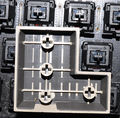Difference between revisions of "Return key"
m (→Terminology: Re-link) |
m (Changed order of pictures to match text) |
||
| Line 13: | Line 13: | ||
<gallery widths=250 heights=187> | <gallery widths=250 heights=187> | ||
| + | File:ANSI Backspace.jpg|ANSI enter and 2u backspace | ||
File:ISO return and 2u backspace.jpg|[[ISO]] enter and 2u backspace | File:ISO return and 2u backspace.jpg|[[ISO]] enter and 2u backspace | ||
| + | File:Japan_Backspace.jpg|JIS enter (identical to ISO enter) and 1u backspace | ||
File:Big-ass return and 1u backspace.jpg|Big-ass enter and 1u backspace | File:Big-ass return and 1u backspace.jpg|Big-ass enter and 1u backspace | ||
| − | |||
| − | |||
</gallery> | </gallery> | ||
Revision as of 02:20, 22 December 2013
A keyboard's return key (often called enter key although it is technically a different key) either executes a dialog's main function or starts a new line, depending on the context in which it is used. Although many PC keyboards label this key "Enter", on the Macintosh the return key and enter key are distinct and serve different purposes.
Variants



Depending on the keyboard layout the return key has different shapes. Many touch typists prefer the so called ANSI enter, which is found on keyboards with US ANSI keyboards, because it is easier to reach with the right pinky. On European layouts the so called ISO enter is predominant, which is bigger in size but more difficult to reach with the pinky.
The so-called big-ass enter is a combination of the two. Often with the big-ass enter, the '\' key has to be relocated, at the expense of having a smaller backspace or right shift key. It is sometimes used as a compromise to please both ANSI and ISO typists. There have also been studies that have claimed that the big-ass enter would be easier to hit accurately than other shapes.
ISO enter and 2u backspace
Terminology
There is a controversy about how to name different styles of return or enter keys.
The only unambiguous naming:
- ANSI enter
- Horizontal key in single row, usually 2.25 units wide.
- ISO enter
- Vertical key in 2 rows (row 2 and 3 actually), 1.5 units wide in row 2, 1.25 units in row 3.
- Big-ass enter
- A combination of both, i.e. 1.5 units in row 2 and 2.25 units in row 3.
Other designations are m-shape, J-shape and L-shape for ANSI, ISO and big-ass, respectively. Some have a different point of view and see the big-ass as J-shape and the ISO as L-shape.
The ISO enter is also known as European enter as most European standard layouts are based on the ISO layout.
The big-ass enter is sometimes called Asian enter because it is found on many East Asian keyboards. Many vintage keyboards with otherwise ANSI and ISO layouts used big-ass enter keys, in particular Alps SKCL/SKCM series and Alps clone boards from Asia.




